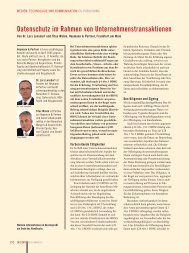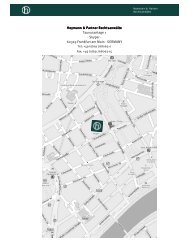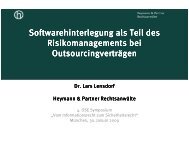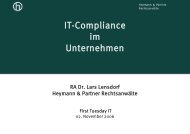e-commerce LAW & STRATEGY - Heymann & Partner, Rechtsanwälte
e-commerce LAW & STRATEGY - Heymann & Partner, Rechtsanwälte
e-commerce LAW & STRATEGY - Heymann & Partner, Rechtsanwälte
You also want an ePaper? Increase the reach of your titles
YUMPU automatically turns print PDFs into web optimized ePapers that Google loves.
Trademark<br />
continued from page 7<br />
domain names using the word<br />
Nissan. The court found that the<br />
computer firm’s registration resulted<br />
in consumer confusion for several<br />
reasons, including initial interest confusion<br />
and actual confusion.<br />
The court found initial interest<br />
confusion because the Nissan name<br />
might have led a consumer to believe<br />
that it was a Web site for Nissan cars,<br />
and that alone is enough to find consumer<br />
confusion. The court also<br />
found actual confusion because nearly<br />
all the computer company’s revenue<br />
stemmed from visitors to the<br />
Web site clicking on automobile<br />
advertisements displayed on it.<br />
Despite this, the court was careful to<br />
point out that there is a “judicial<br />
reluctance to enjoin use of a personal<br />
name” even when it apparently<br />
infringes on a trademark, but that it<br />
was still possible to limit the use with<br />
a “carefully tailored injunction.”<br />
This case and others resulted in the<br />
enactment of the Anti-Cybersquatting<br />
Consumer Protection Act.<br />
Additionally, the Internet Corporation<br />
for Assigned Names and Numbers<br />
(“ICANN”) adopted its Uniform<br />
Domain Name Dispute Resolution<br />
Policy to provide an alternative to litigation<br />
in dealing with abusive<br />
domain-name registrations.<br />
Meta Tags<br />
The second trademark infringement<br />
issue unique to the Internet<br />
entails meta tags, which provide<br />
Internet page-setting information that<br />
is normally invisible to a user. Meta<br />
tags are commonly used by search<br />
engines, such as Google, to index site<br />
content. The content of meta tags,<br />
when properly used, gives content<br />
some context. Four types of content<br />
are often used as a part of meta tags:<br />
• Resource type;<br />
• Key word;<br />
• Description; and<br />
• Distribution.<br />
The unauthorized use of another’s<br />
mark as an element of meta-tag content<br />
could result in infringement.<br />
The use of registered marks as part<br />
of a meta tag might result in consumer<br />
confusion and, as such, could<br />
8<br />
be a basis for infringement litigation;<br />
for example, the use of various<br />
“Playboy” trademarks in meta-tag<br />
lines. (See, Playboy Enter., Inc. v.<br />
Calvin Designer Label, 985 F. Supp.<br />
1220 (N.D. Cal. 1997) and Playboy<br />
Enter., Inc. v. Torri Welles, 7 F. Supp.<br />
2d 1098 (S.D. Cal. 1998)).<br />
The Seventh and Ninth District<br />
courts have ruled that meta-tag use<br />
might infringe on famous marks.<br />
(See, Promatek Indus. v. Equitrak<br />
Corp., 300 F.3d 808 (7th Cir. 2002);<br />
and Brookfield Communications v.<br />
West Coast Entertainment, 174 F.3d<br />
1036 (9th Cir. 1999)). Both courts<br />
have followed the same line of reasoning,<br />
holding that the “initial interest<br />
confusion” that consumers experience,<br />
regardless of whether it<br />
results in actual confusion once they<br />
are viewing the Web site, is adequate<br />
for the imposition of trademarkinfringement<br />
liability. It should be<br />
noted that the Promatek decision<br />
was amended to state that meta-tag<br />
usage by a defendant come into play<br />
only when the infringing company is<br />
actually using the trademark to<br />
deceive consumers.<br />
Hyperlinks<br />
Hyperlinks are the third trademarkinfringement<br />
issue unique to the<br />
Internet. A hyperlink is an element of<br />
an electronic document that links to<br />
another place in the same document<br />
or to an entirely different document.<br />
Users typically click on the hyperlink<br />
to follow the link to the document to<br />
which it is connected. Hyperlinks are<br />
an indispensable constituent of all<br />
hypertext systems, such as the World<br />
Wide Web. Hyperlink use, however,<br />
has the potential for trademark<br />
infringement, and allegations have<br />
been made that hyperlinks can cause<br />
trademark-infringement problems in<br />
the form of passing off, reverse passing<br />
off, and false advertising.<br />
Framing<br />
Framing is the fourth way that a<br />
trademark can be violated on the<br />
Internet. Framing occurs when one<br />
Internet site displaces another site’s<br />
content by surrounding or framing it<br />
with a portion of its own site. In the<br />
case of TotalNews (The Washington<br />
Post v. TotalNews, Southern District<br />
of New York, Civil Action Number<br />
e-Commerce Law & Strategy ❖ www.ljnonline.com/alm?ecomm<br />
97-1190), the Washington Post and<br />
other newspaper publishers brought<br />
suit against an Internet news site for<br />
using framing technology to display<br />
the news organizations’ information<br />
on the TotalNews site and surrounding<br />
the other content with its own<br />
advertising. This practice was found<br />
to be tantamount to trademark dilution<br />
because the framing practice<br />
was likely to confuse users in that<br />
they would be led to believe that the<br />
source of these advertisements was<br />
the plaintiffs’ newspapers.<br />
DOUBLE JEOPARDY<br />
The special trademark-infringement<br />
problems that the Internet presents<br />
(domain names, hyperlinks,<br />
meta tags and framing) are in addition<br />
to the amplification of traditional<br />
trademark infringement that results<br />
from the worldwide use of the<br />
Internet. Consider the international<br />
trademark-infringement difficulties<br />
faced by Playboy Enterprises. In<br />
Playboy Enter., Inc. v. Chuckleberry<br />
Publ’g, Inc., 687 F.2d 563 (2d Cir.<br />
1982), the Second Circuit Court of<br />
Appeals had granted an injunction,<br />
enjoining Chuckleberry from using<br />
the confusingly similar mark<br />
Playmen for the distribution of<br />
Chuckleberry’s Italy-based magazine.<br />
Despite this judicial result in a parallel<br />
suit brought to enjoin<br />
Chuckleberry’s use in Italy, the<br />
Italian court upheld the use of the<br />
Playmen mark.<br />
Subsequently, in Playboy Enter.,<br />
Inc. v. Chuckleberry Publ’g Inc., 939<br />
F. Supp 1032 (S.D.N.Y. 1996), when<br />
Chuckleberry published an Internet<br />
Web site for its magazine, again<br />
using the mark Playmen, based in<br />
Italy, Playboy brought suit for a violation<br />
of the injunctive order granted<br />
in the prior Playboy v. Chuckleberry<br />
case, citing that the worldwide<br />
continued on page 12<br />
<strong>LAW</strong> JOURNAL NEWSLETTERS<br />
REPRINT SERVICE<br />
Promotional article reprints of this article or any<br />
other published by <strong>LAW</strong> JOURNAL NEWSLETTERS<br />
are available.<br />
Call Matt Solomon at 212-545-6289 or<br />
e-mail msolomon@alm.com<br />
for a free quote.<br />
Reprints are available in paper and PDF format.<br />
June 2007








